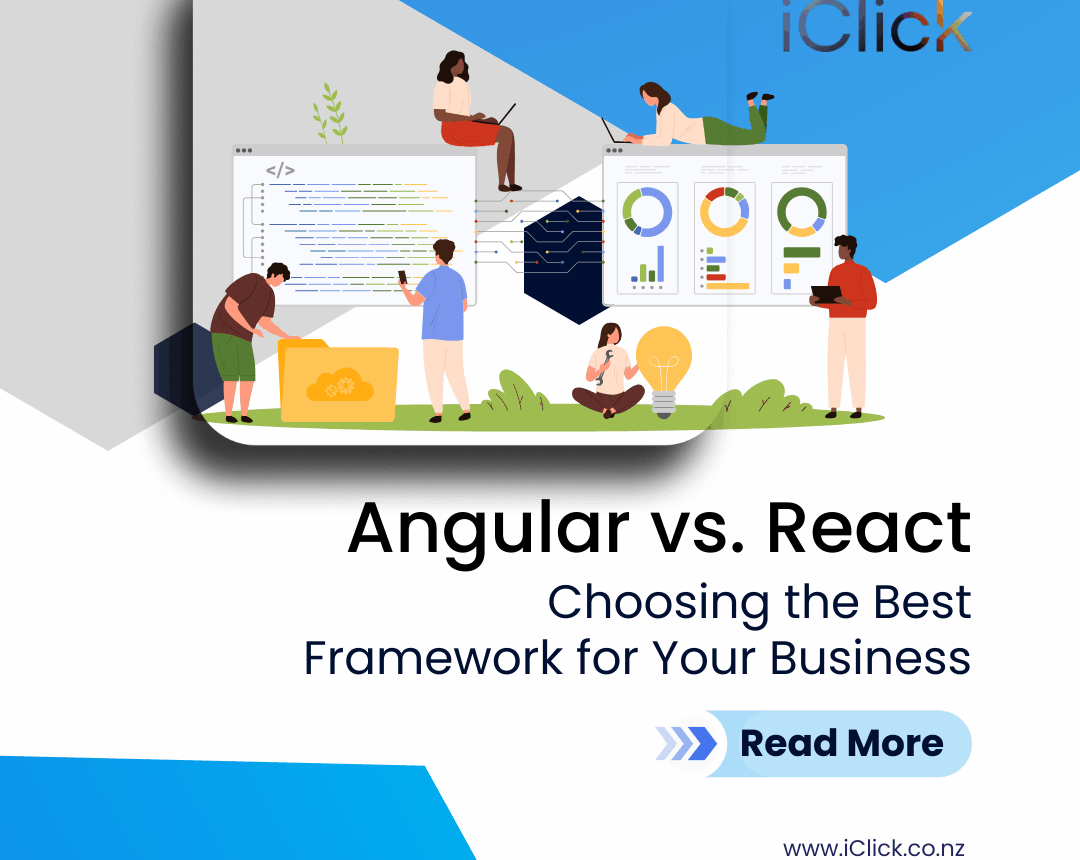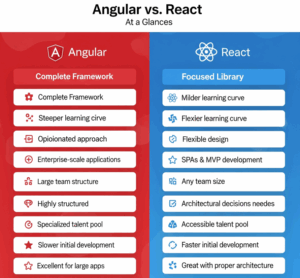Angular vs. React: Which is the Right Choice for Your Business?

When it comes to web development in Australia, selecting the right front-end framework is crucial. Angular and React are two of the most popular options, each offering unique advantages depending on project requirements, team size, and long-term business goals. This guide helps Australian businesses make informed decisions to maximise efficiency, scalability, and performance.
- Angular: Best for enterprise web application development with large teams, complex requirements, and long-term scalability needs
- React: Ideal for single-page application benefits, rapid MVP development, and projects requiring maximum flexibility.
- Both have strong community support and proven track records with major companies.
- Decision factors: Team size, timeline, budget, and long-term vision matter more than technology preference
- Bottom line: Choose based on your specific business needs; we can help you decide
Executive Summary
Choosing between Angular and React isn’t about which front-end framework comparison yields a “winner”; it’s about finding the right fit for your specific business needs. Angular excels as a comprehensive framework for enterprise-scale applications that require structure and long-term maintainability. At the same time, React shines as a flexible library ideal for rapid development and creating interactive user experiences. This guide will help you make an informed decision based on your project goals, timeline, team composition, and budget considerations.
Did you know that 68% of businesses report their web application choice significantly impacts their time-to-market and long-term development costs? Yet many companies still make technology decisions based on developer preferences rather than strategic business requirements.
Picture this common scenario: Your startup needs to validate a product concept quickly, but your CTO insists on using the same enterprise-grade framework they used at their previous Fortune 500 Company. Six months later, you’re still building features that a more agile approach could have delivered in a matter of weeks.
This is exactly why understanding the business implications of your technology choices matters more than following the latest trends.
When it comes to building modern web applications, two names consistently rise to the top: Angular and React. Both are powerhouse technologies that have transformed how we create digital experiences, but choosing between them can feel overwhelming, especially when you’re focused on business outcomes rather than technical specifications.
The truth is, both Angular and React are excellent choices for enterprise web application development. The “best” option isn’t about which technology is superior in a vacuum; it’s about which one aligns perfectly with your project’s goals, timeline, and long-term vision.
Let’s cut through the technical noise and explore how each technology translates into real business benefits.
Choose Angular for Enterprise-Level Applications
Think of Angular as the comprehensive toolkit for ambitious projects. Developed by Google, Angular is a complete framework, not just a library, that provides everything you need to build robust, scalable applications right out of the box.
Perfect Fit Scenarios
Angular excels when you’re building:
- Banking platforms and financial services that require rock-solid security and compliance
- Large e-commerce sites handling thousands of products and complex user interactions
- Internal management systems where consistency and maintainability are crucial
- Enterprise applications that multiple teams will work on over many years
Key Business Advantages
- Structure and Consistency: Angular’s opinionated approach means your development team follows established patterns and conventions. This translates to more predictable timelines, easier onboarding of new developers, and code that’s maintainable years down the line.
- Long-term Scalability: When your application needs to grow—whether that’s adding new features, supporting more users, or expanding to new markets—Angular’s comprehensive architecture provides a solid foundation that won’t require major rewrites.
- Enterprise-Ready Features: Built-in solutions for common enterprise needs like dependency injection, routing, and form handling mean less time reinventing the wheel and more time focusing on your unique business logic.
Real-World Success Stories
Major enterprises trust Angular for their mission-critical applications with measurable results:
- Deutsche Bank implemented Angular for its trading platforms, resulting in 40% faster development cycles and improved code maintainability across its global development teams.
- Samsung leverages Angular for its enterprise solutions, achieving a 35% reduction in onboarding time for new developers due to Angular’s structured approach.
- Microsoft’s Office 365 suite relies on Angular components, enabling them to maintain consistency across 200+ million users while reducing UI bug reports by 50%
When Angular Isn’t the Right Choice
Angular may not be ideal if you’re building a simple marketing website, need to prototype rapidly with limited developer resources, or require maximum flexibility to experiment with unconventional user interface patterns. The learning curve can also slow initial development for smaller teams working on tight deadlines.
Choose React for Speed and Flexibility
React takes a different approach. Created by Facebook, it’s a focused library that excels at building user interfaces with maximum flexibility and minimal constraints, perfect for maximising single-page application benefits.
Ideal Use Cases
React is your go-to choice for:
- Single-Page Applications (SPAs) that need to feel fast and responsive
- Interactive user interfaces where user experience is the primary differentiator
- MVP (Minimum Viable Product) development when speed to market is critical
- Projects requiring frequent pivots or experimental features
Strategic Business Benefits
Faster Time to Market: React’s gentler learning curve means your team can become productive quickly. The vast ecosystem of ready-made components can dramatically accelerate development timelines.
Flexibility for Innovation: React doesn’t lock you into specific patterns or structures. As your business requirements evolve, React adapts with you rather than against you.
Cost-Effective Scaling through Reusability: React’s component-based architecture delivers real cost savings. Once you build a button, form field, or navigation component, it can be reused across your entire application—and even across multiple projects. This means less duplicated effort, faster feature development, and lower maintenance costs. A well-designed React component library can reduce development time for new features by 30-50%.
Industry Leaders Using React
Top companies have achieved remarkable results with React:
- Netflix built its user interface with React, handling 230 million subscribers globally while reducing page load times by 70% through efficient component rendering
- Airbnb chose React for its booking platform, enabling it to A/B test new features 60% faster and achieve 25% higher conversion rates through improved user interactions.
- WhatsApp Web leverages React to provide seamless real-time messaging, supporting over 2 billion users with 99.9% uptime reliability.
When React Isn’t the Right Fit
React might not be suitable for large enterprise applications where strict architectural consistency is paramount, projects requiring extensive built-in functionality without additional libraries, or teams that prefer comprehensive documentation and opinionated best practices over flexibility.
Hybrid Approaches: The Best of Both Worlds
Progressive companies often leverage both technologies strategically within their ecosystem:
- IBM uses Angular for its internal enterprise management systems (Watson Studio) while employing React for customer-facing marketing websites and interactive demos
- Microsoft runs Angular-based Office 365 applications alongside React-powered Skype web interfaces
- Adobe maintains Angular applications for Creative Cloud enterprise dashboards while using React for their customer support portals.
This approach allows organisations to optimise each application for its specific requirements rather than forcing a one-size-fits-all solution.
Community Support and Ecosystem: A Business Advantage
Both technologies boast exceptional community support, but in different ways that impact your business:
Angular’s Enterprise Focus: Backed by Google with predictable release cycles and long-term support commitments. The community emphasises enterprise-grade solutions, extensive documentation, and professional training resources. This translates to lower risk for mission-critical applications and easier compliance with corporate development standards.
React’s Innovation Velocity: With Facebook’s backing and the largest developer community, React innovations happen rapidly. The npm ecosystem offers solutions for virtually any requirement, often with multiple options to choose from. This means faster problem-solving, more third-party integrations, and access to cutting-edge UI patterns as they emerge.
Developer Talent and Hiring Considerations
Your technology choice significantly impacts your hiring strategy and development costs:
Angular Developers: Often come from enterprise backgrounds with strong architectural skills. They’re typically more expensive to hire but bring structured thinking and best practices. Angular’s steeper learning curve means longer onboarding times but more consistent code quality across team members.
React Developers: More abundant in the job market due to React’s popularity and gentler learning curve. This abundance can mean more competitive hiring costs and faster team expansion. However, React’s flexibility requires senior developers to guide architectural decisions and maintain code consistency.

Future Outlook: Staying Ahead of the Curve
Both technologies continue evolving with strong roadmaps:
Angular’s Direction: Google is doubling down on enterprise features, improved performance, and seamless TypeScript integration. Recent updates focus on making large-scale application development more efficient, with better tree-shaking and bundle optimisation that can reduce application bundle sizes by up to 30%.
React’s Evolution: Facebook continues pushing the boundaries of user experience with features like concurrent rendering and server components. The focus remains on performance optimisation and developer experience improvements, with recent updates showing 40% faster rendering for complex applications.
Both have committed to long-term support and active development, making either a safe choice for business continuity.
Making the Strategic Decision
The decision between Angular and React shouldn’t be made in isolation. Consider these critical business factors:
Timeline Constraints: If you need to validate a concept quickly or beat competitors to market, React’s flexibility might give you the edge. For complex applications where thorough planning pays dividends, Angular’s structure provides a clearer roadmap.
Team Composition: Do you have a large development team that would benefit from Angular’s structured approach? Or a smaller, agile team that thrives with React’s flexibility?
Future Vision: Are you building a foundation for years of growth and feature expansion? Angular’s enterprise focus might serve you better. Building something that needs to pivot quickly based on user feedback? React’s adaptability could be invaluable.
Budget and Risk Tolerance: Both technologies can be cost-effective, but in different ways. React might get you to market faster, while Angular might reduce long-term maintenance costs and architectural risks.
Your Technology Partner Makes All the Difference
At iClick, we’ve built successful applications with both Angular and React across industries ranging from fintech to e-commerce. Our expertise isn’t tied to a single technology, it’s rooted in understanding your business needs and matching them with the right technical approach.
Whether you’re launching a startup’s MVP or architecting an enterprise platform, we’ll help you navigate this front-end framework comparison with confidence. Because ultimately, the best technology is the one that serves your business goals most effectively.
Ready to transform your digital presence? Let’s discuss your unique requirements and find the perfect technology solution that drives real business results.
Schedule a free consultation, and let’s turn your vision into reality with a tailored recommendation for your specific needs.
Why iClick Online Technology?
At iClick Online Technology, we provide end-to-end software and web solutions for Australian businesses:
- Adaptive Software Development & Agile System Development
- WordPress Website Design & Webflow CMS Development
- Shopify Development Partners & E-Commerce Solutions
- AI Integration & Intelligent Agent Development
- Custom Mobile & Web App Development (Flutter, React Native, Swift, Kotlin)
Our solutions are secure, scalable, and user-friendly, helping businesses thrive in the competitive digital landscape. Partner with iClick Online Technology to choose the right framework, optimise development costs, and deliver exceptional digital experiences.
Lets create something extraordinary. Partner with us.
Start by saying hello